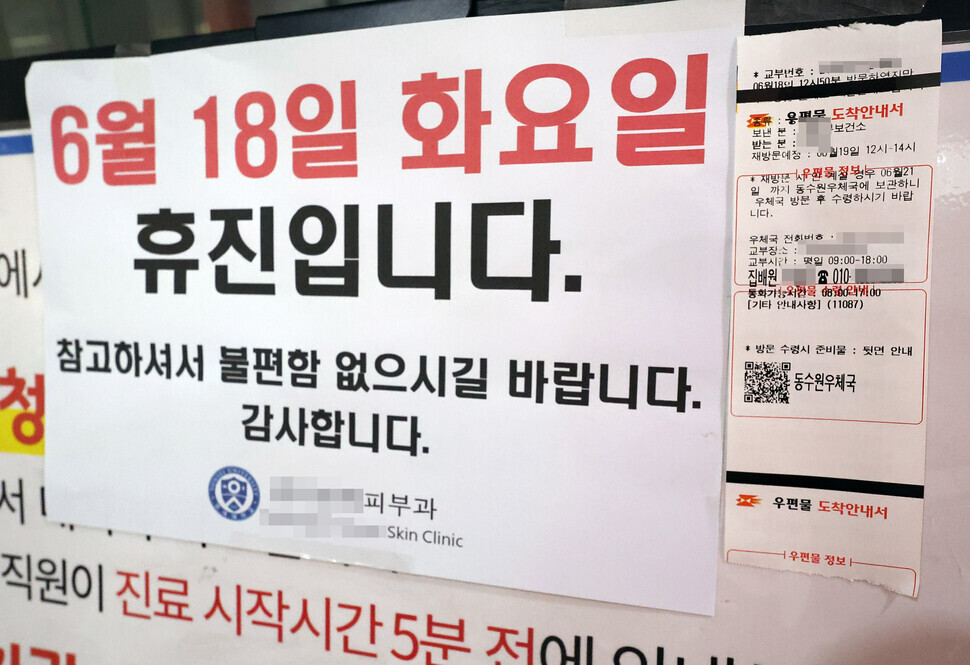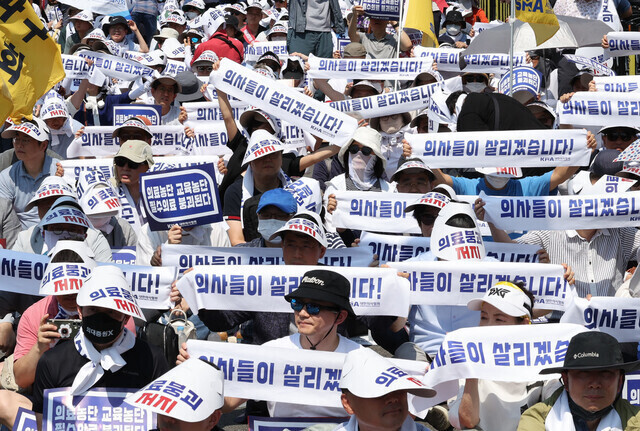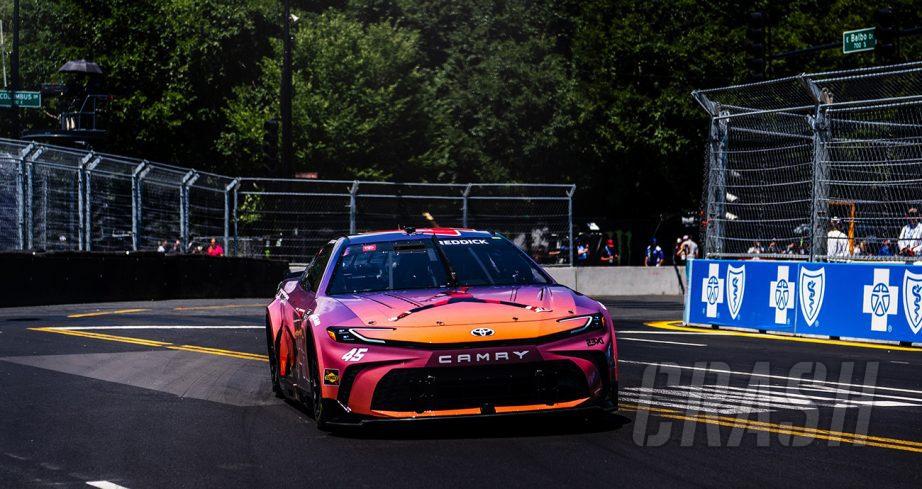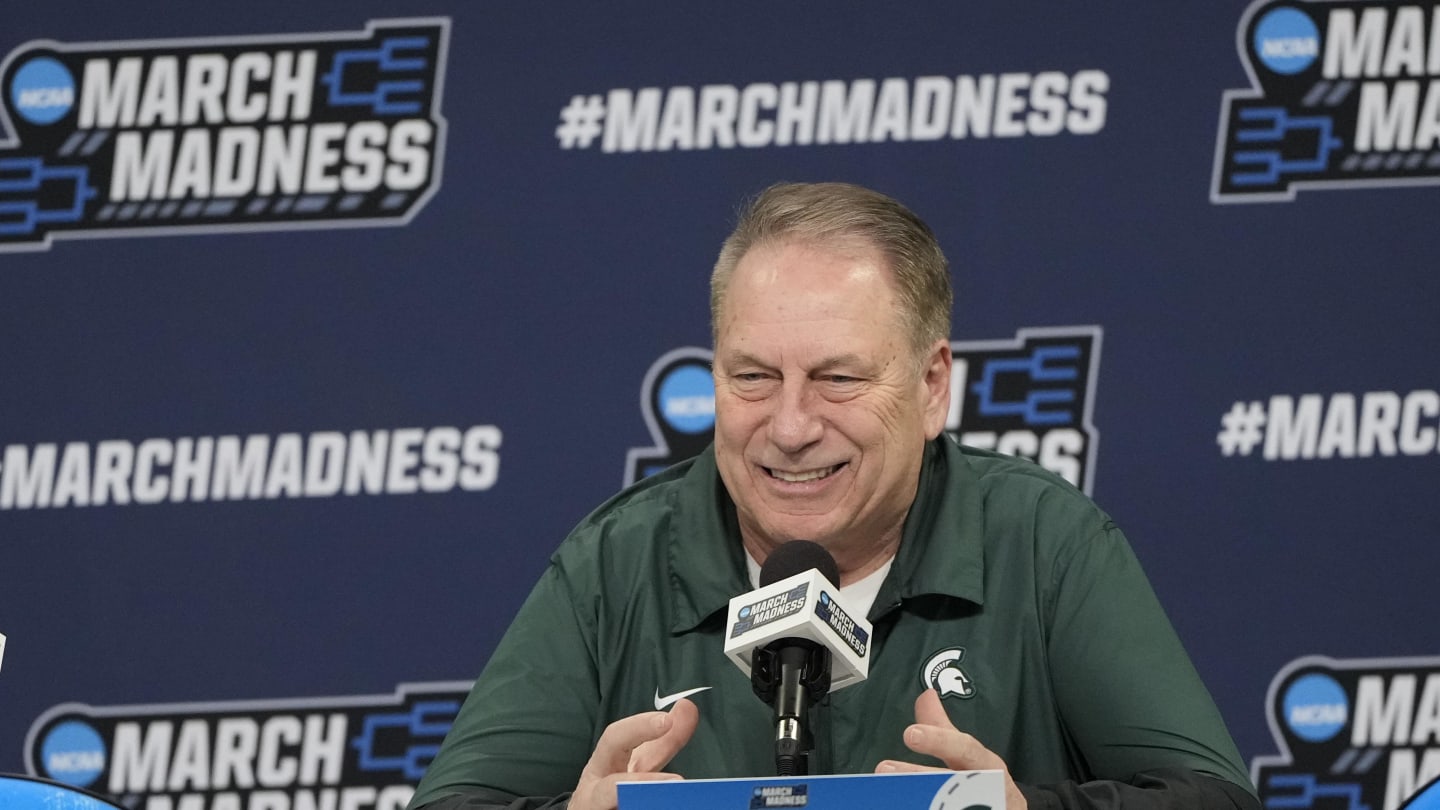Despite public dissatisfaction, the participation of hospitals in the strike is disappointing

A sign on the door of a dermatologist’s office in Seoul says it is closed on Tuesday, June 18. Next to it hangs a notice about a missed package from the post office. (Yonhap)
On Tuesday, parents in Seoul’s Haengdang district took their four-year-old daughter to the local pediatrician because she had a cold. But the couple had to scramble to find another doctor’s office when they realized that their local pediatrician was one of many doctors who had closed their offices for the day as part of a mass strike in protest against the government’s health care policies.
“We tried our luck with another pediatrician, but he only accepted patients in the morning,” the mother told Hankyoreh. “I wanted to see a doctor quickly so I could send my daughter to kindergarten, but there were so many people there that we had to wait another half hour.”
As some general practitioners joined the Korean Medical Association’s (KMA) general strike on Tuesday, many Koreans seeking medical care were left in the lurch. However, contrary to the KMA’s warnings of high turnout, only 14.9 percent of hospitals nationwide took part in the strike.
Despite the low turnout, KMA President Lim Hyun-taek announced plans to begin an indefinite strike starting June 27. The government warned that such action could lead to the dissolution of the KMA, which is a statutory body.
According to a survey conducted on Tuesday by the Ministry of Health and Social Affairs and the Ministry of Interior and Security on the rate of strikes in hospitals and clinics across the country, 14.9 percent of these medical facilities were closed for the day.
Daejeon recorded the highest strike participation rate at 22.9%, while South Jeolla Province had the lowest at 6.4%. Individual local governments planned to monitor whether hospitals were closed on Tuesday morning and afternoon. If the closure rate was above 30%, local government officials would visit medical facilities to verify their closures and impose administrative penalties for ignoring the government’s order to resume work.

Doctors hold signs reading “Doctors, rush to help!” at a mass rally in Seoul’s Yeongdeungpo district on June 18, 2024. (Baek So-ah/The Hankyoreh)
However, none of these measures were implemented, as none of the regions had rates above the 30% threshold. Initially, the KMA had predicted that a significant number of clinics would join the strike, based on an incredibly high strike support rate of 73.5% in a survey conducted in the first week of June. In reality, however, participation was only half of what it was during the mass strike on August 14, 2020, when it reached 32.6%.
The low turnout may be due to the fact that, given the extremely negative public opinion of the strike, private doctors were hesitant to close their practices in front of the people in their neighborhood, from whom they earn their living.
Lists of clinics in their districts that had joined the general strike circulated on the Internet. Some commentators declared that they would boycott the clinics participating in the strike.
“For doctors who depend on performing treatments to pay their staff and other expenses, even a single day off can be quite a burden,” the director of a tertiary general hospital in Seoul told Hankyoreh.
Some major hospitals in Seoul also saw a drop in surgeries on Tuesday. The Emergency Faculty Committee of Ulsan University School of Medicine said 76 surgeries were performed at Asan Medical Center on Tuesday, about half the number of surgeries that took place a week earlier, on June 11 (149 surgeries).
The number of outpatient treatments and surgeries at Seoul National University Hospital and Seoul St. Mary’s Hospital also fell compared to normal. At Samsung Medical Center, however, outpatient treatments and surgeries were more or less at the same level as last week.
“We (normally) perform around 8,500 outpatient procedures every day, and today was similar,” said a Samsung Medical Center official, adding that “less than 10 professors applied for leave or terminated their service today.”
The KMA announced that it would continue its military response with a nationwide rally of doctors to “stop the manipulation of the health system” on Tuesday at 2 p.m.
“We call for an immediate end to the unjust oppression of interns, residents and medical students, and an increase in admissions to medical schools, which will plunge the level of health care into the basement,” said KMA Chairman Lim Hyun-taek.
“If the government does not accept these reasonable demands, we will begin an indefinite strike on June 27,” he announced.
The government also threatened a strong legal response.
While chairing a cabinet meeting at his presidential office in Yongsan on Tuesday, President Yoon Suk-yeol said: “As it is the government’s duty to protect the lives and health of its people, we have no choice but to respond strictly to illegal acts that abandon patients.”
By Cheon Ho-sung, editor; Lim Jae-hee, editor; Lee Seung-jun, editor; Lee Ji-hye, editor
Please direct any questions or comments to ([email protected])

)

